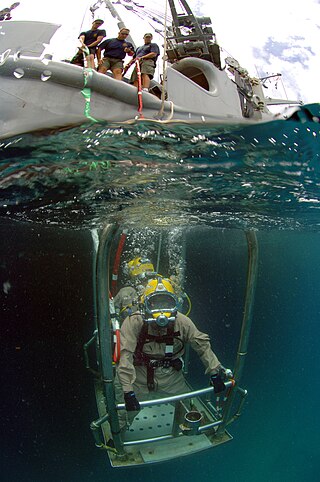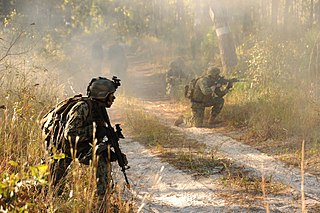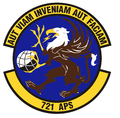
Lucius Annaeus Seneca the Younger, usually known mononymously as Seneca, was a Stoic philosopher of Ancient Rome, a statesman, dramatist, and in one work, satirist, from the post-Augustan age of Latin literature.
This is the Operation Telic order of battle, which lists the British forces that took part in Operation Telic, including

E pluribus unum – Latin for "Out of many, one" – is a traditional motto of the United States, appearing on the Great Seal along with Annuit cœptis and Novus ordo seclorum which appear on the reverse of the Great Seal; its inclusion on the seal was approved in an act of the Congress of the Confederation in 1782. The first word of E pluribus unum is actually an abbreviation of the Latin preposition ex, meaning “out of.” While its status as national motto was for many years unofficial, E pluribus unum was still considered the de facto motto of the United States from its early history. Eventually, the U.S. Congress passed an act in 1956, adopting "In God We Trust" as the official motto.

The Royal Logistic Corps provides logistic support functions to the British Army. It is the largest Corps in the Army.
United States special operations forces (SOF) are the active and reserve component forces of the United States Army, Marine Corps, Navy and Air Force, as designated by the Secretary of Defense and specifically organized, trained, and equipped to conduct and support special operations. All active and reserve special operations forces are assigned to the United States Special Operations Command (USSOCOM).

Joint Expeditionary Base–Little Creek (JEB–LC), formerly known as Naval Amphibious Base Little Creek and commonly called simply Little Creek, is the major operating base for the Amphibious Forces in the United States Navy's Atlantic Fleet. The base comprises four locations in three states, including almost 12,000 acres (4,900 ha) of real estate. Its Little Creek location in Virginia Beach, Virginia, totals 2,120 acres (860 ha) of land. Outlying facilities include 350 acres (140 ha) located just north of Training Support Center Hampton Roads in Virginia Beach and 21 acres (8.5 ha) known as Radio Island at Morehead City, North Carolina, used for U.S. Coast Guard ships and personnel as well as serves as an amphibious embarkation/debarkation area for U.S. Marine Corps units at Marine Corps Base Camp Lejeune, North Carolina. It is also home to the Naval School of Music.
Ad astra is a Latin phrase meaning "to the stars". The phrase has origins with Virgil, who wrote in his Aeneid: "sic itur ad astra" and "opta ardua pennis astra sequi". Another origin is Seneca the Younger, who wrote in Hercules: "non est ad astra mollis e terris via".

A clearance diver was originally a specialist naval diver who used explosives underwater to remove obstructions to make harbours and shipping channels safe to navigate, but the term "clearance diver" was later used to include other naval underwater work. Units of clearance divers were first formed during and after World War II to clear ports and harbours in the Mediterranean and Northern Europe of unexploded ordnance and shipwrecks and booby traps laid by the Germans.

The EXW qualification is a warfare qualification awarded to enlisted United States Navy personnel assigned to U.S. Navy expeditionary combat units, who satisfactorily complete the required qualification course and pass a qualification board hearing. The program was approved July 31, 2006 by then-Chief of Naval Operations Adm. Michael Mullen.

The Royal Australian Army Ordnance Corps (RAAOC) is the Corps within the Australian Army concerned with supply and administration, as well as the demolition and disposal of explosives and salvage of battle-damaged equipment. The Corps contains clerks, operator supplies, petroleum operators, parachute riggers and ammunition technicians. Members of the Corps are nicknamed Roaches.
11 Explosive Ordnance Disposal and Search Regiment RLC is a specialist regiment of the British Army's Royal Logistic Corps (RLC) responsible for counter terrorist Explosive Ordnance Disposal (EOD), the safe recovery or disposal of conventional munitions. The regiment also has an ammunition inspectorate role supporting the Inspector Explosives (Army). With headquarters in Didcot, the regiment has sub units geographically based throughout the UK to provide a nationwide high readiness response capability in support of the police.

Naval Amphibious Base Coronado is a US naval installation located across the bay from San Diego, California. The base, situated on the Silver Strand, between San Diego Bay and the Pacific Ocean, is a major Navy shore command, supporting over 30 tenant commands, and is the West Coast focal point for special and expeditionary warfare training and operations. The on‑base population is 5,000 military personnel and 7,000 students and reservists. The base is one of the eight components of Naval Base Coronado (NBC).
This is the Operation Herrick ground order of battle, which lists any British ground forces that have taken part in the duration of Operation Herrick between 2002 and 2014.

The US employs divers in several branches of the armed forces, including the navy, army, marines, air force and coast guard.
Docendo discimus is a Latin proverb meaning "by teaching, we learn."

Air Forces Panama is an inactive United States Air Force (USAF) headquarters. It was assigned to Tactical Air Command, most recently to Twelfth Air Force. Its headquarters were located at Albrook Air Force Station and Howard Air Force Base in the Panama Canal Zone. The organization was inactivated on 11 February 1992.

Underwater Construction Teams (UCT) are the United States Navy Seabees' underwater construction units numbered 1 and 2 that were created in 1974. A team is composed of divers qualified in both underwater construction and underwater demolition. Possible tasks can be: battle damage repairs, structural inspections and assessments, demolition of waterline facilities or submerged obstructions, installation of submerged surveillance systems, or harbor and channel clearance. As needed, teams may test and or evaluate new or existing aquatic systems or equipment. Extending construction, whether vertical or horizontal, beyond the shoreline and waterline is their specialty. Reflecting Seabee tradition, teams are expected to execute underwater construction anywhere, anytime, under any conditions.



















